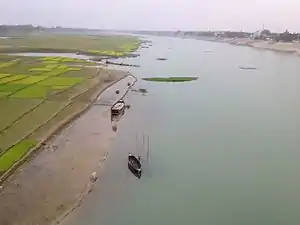Mahananda River
The Mahananda River (Pron:/ˌməhɑːˈnʌndə or ˌmɑːhəˈnʌndə/) is a trans-boundary river that flows through the Indian states of Bihar and West Bengal, and Bangladesh. It is an important tributary of river Ganga.
| Mahananda River | |
|---|---|
.jpg.webp) | |
| Location | |
| Countries | India and Bangladesh |
| States | West Bengal (India) Bihar (India) |
| Divisions | Rangpur (Bangladesh) Rajshahi (Bangladesh) |
| Districts | Jalpaiguri (India) Uttar Dinajpur (India) Kishanganj (India) Purnia (India) Katihar (India) Malda (India) Panchagarh (Bangladesh) Nawabganj (Bangladesh) |
| Cities | Kurseong (India) Siliguri (India) Godagiri (Bangladesh) |
| Physical characteristics | |
| Source | Paglajhora Falls, Darjeeling hills in the Himalayas |
| Mouth | Ganges |
• location | Godagiri, Nawabganj District, Bangladesh |
• coordinates | 24°29′24″N 88°18′14″E |
| Length | 360 km (220 mi) |
| Basin size | 20,600 km2 (8,000 sq mi) |
| Basin features | |
| Tributaries | |
| • left | Tangon River, Nagar River (Rangpur) |
| • right | Mechi River, Kankai River, Balason River, Kalindri River |
Course

The Mahananda originates in the Himalayas: Paglajhora Falls on Mahaldiram Hill near Chimli, east of Kurseong in Darjeeling district at an elevation of 2,100 metres (6,900 ft).[1][2][3] It flows through Mahananda Wildlife Sanctuary and descends to the plains near Siliguri. It touches Jalpaiguri district.[2][4]
It enters Bangladesh near Tentulia in Panchagarh District, flows for 3 kilometres (1.9 mi) after Tentulia and returns to India.[5] After flowing through Uttar Dinajpur district in West Bengal and Kishanganj, Purnia and Katihar districts in Bihar, it enters Malda district in West Bengal.[6][7] The Mahananda divides the district into two regions — the eastern region, consisting mainly of old alluvial and relatively infertile soil is commonly known as Barind (Borendrovomee), and the western region, which is further subdivided by the river Kalindri into two areas, the northern area is known as "Tal". It is low-lying and vulnerable to inundation during rainy season; the southern area consists of very fertile land and is thickly populated, being commonly known as "Diara".[8]
It joins the Ganges at Godagiri in Nawabganj district in Bangladesh.[1]
Basin data
The total length of the Mahananda is 360 kilometres (220 mi),[9] out of which 324 kilometres (201 mi) are in India and 36 kilometres (22 mi) are in Bangladesh.
The total drainage area of the Mahananda is 20,600 square kilometres (8,000 sq mi) out of which 11,530 square kilometres (4,450 sq mi) are in India.[1]
Tributaries
The main tributaries of the Mahananda are Balason, Mechi, Kankai[1] and River Kalindri. At the East of the confluence of the Kalindri and the Mahananda lies the Old Malda town. In the Siliguri area it has three tributaries called the Trinai, Ranochondi and the pair of Chokor and Dauk taken as a single tributary.[2]
History
The Kosi (Kausiki), which flows through the northeastern Bihar and joins the Ganges at a point much higher up than Rajmahal, originally ran eastward and fell into the Brahmaputra . The channel of the Kosi, therefore, must have been steadily shifting toward the west, right across the whole breadth of North Bengal. There was a time when the Kosi and the Mahananda joined the Karatoya and formed a sort of ethnic boundary between people living south of it and the Kochs and Kiratas living north of the river.[10]
References
- Sharad K. Jain; Pushpendra K. Agarwal; Vijay P. Singh (2007). Hydrology and Water Resources of India. Springer Science & Business Media. p. 360. ISBN 978-1-4020-5180-7.
- "Rivers in Siliguri". Mahananda River. Siliguri on line. Archived from the original on 4 January 2013. Retrieved 14 May 2010.
- "Rivers". Darjeeling News.Net. Retrieved 14 May 2010.
- "Mahananda Wildlife Sanctuary". nature beyond. Retrieved 14 May 2010.
- "News from Bangladesh". Retrieved 14 May 2010.
- "Uttar Dinajpur district". Uttar Dinajpur district administration. Retrieved 14 May 2010.
- "Kishanganj district". Kishanganj district administration. Archived from the original on 8 April 2010. Retrieved 14 May 2010.
- "Malda district". Malda district administration. Retrieved 14 May 2010.
- "Mahananda River". Encyclopædia Britannica. Retrieved 14 May 2010.
- R. C. Majumdar (2005) [First published 1971]. History of Ancient Bengal. Kolkata: Tulshi Prakashani. p. 4. ISBN 81-89118-01-3.
External links
- Sultana Nasrin Baby (2012), "Mahananda River", in Sirajul Islam; Ahmed A. Jamal (eds.), Banglapedia: National Encyclopedia of Bangladesh (Second ed.), Asiatic Society of Bangladesh
| Wikimedia Commons has media related to Mahananda River. |